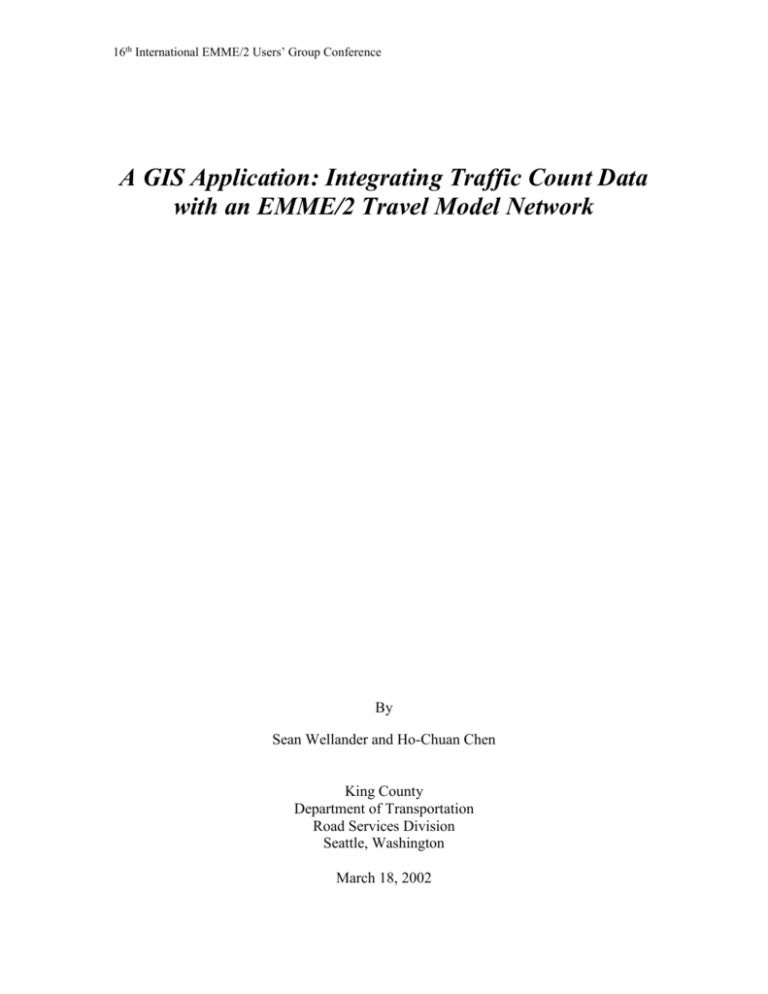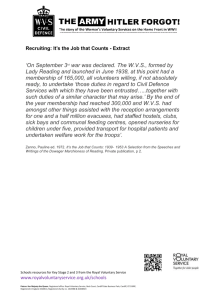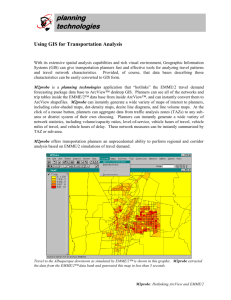A GIS Application: Integrating Traffic Count Data with an
advertisement

16th International EMME/2 Users’ Group Conference A GIS Application: Integrating Traffic Count Data with an EMME/2 Travel Model Network By Sean Wellander and Ho-Chuan Chen King County Department of Transportation Road Services Division Seattle, Washington March 18, 2002 16th International EMME/2 Users’ Group Conference Abstract Accurate traffic counts are vital for the development and application of well-calibrated travel demand models. These traffic counts need to be matched to a model’s directional links and nodes on the EMME/2 travel model network, but creating this linkage is often very labor-intensive and time consuming. To improve the efficiency of the traffic count coding process, King County has developed a method to relate traffic counts stored in a GIS database with specific links in an EMME/2 network. This method applies GIS to identified count station tags on the EMME/2 network, then uses network node coordinates to determine the location and orientation of individual network links. After the count station is linked to the model network, traffic counts can be batched into an EMME/2 network for model validation. This can save significant processing time, and also makes it possible to develop a regional travel model / traffic count database. The resulting system can then be easily updated, as new traffic counts become available. The first section of this paper will introduce the common methods of traffic count collection and application. The general coding process to link these counts with the travel model is described in the second section. The methodology for GIS integration of traffic counts with an EMME/2 network is described in detail in the third section. Finally, conclusions and recommendations on the methodology are presented in the final section. Traffic Count Database Management and Application Accurate traffic counts are vital for the development and application of well-calibrated travel demand models. Counts are typically collected periodically by area jurisdictions, and saved in a variety of formats. Traffic Count Collection and Storage The most frequently used equipment for collecting through traffic counts on local streets and arterials are tube counters; loop-detectors are usually used for freeways. Manual counts are mainly utilized to derive detailed turning movements at intersections. Video cameras are also sometimes used to record both through and turning movement counts. Counts are usually taken on weekdays – ideally collected over at least three consecutive days to obtain the most representative counts. Days that might render an abnormal count because of seasonal, construction, or traffic incident variables are generally avoided. Count results are normally totaled for 15-minute or one-hour intervals. To get the most consistent results, it is preferable to collect counts at different sites using the same time frame, agency, and collection method. Traffic counts are typically stored as hard copy, in electronic format in a spreadsheet or database, or as GIS coverage. King County publishes an annual report “Historical Traffic 2 16th International EMME/2 Users’ Group Conference Counts,” which is available in all three formats. This report contains average weekday daily directional traffic counts for the previous 10 years at about 360 count stations located within unincorporated King County. The data is organized in tabular format. This study will use this King County database for demonstration of the GIS integration process. Traffic Counts Used for Travel Demand Model The following are typical uses for traffic counts in travel demand modeling: Screenline Analysis Screenline analysis is one of the most important tools used for the validation of travel models. Screenlines that monitor travel patterns in the study area are identified, and the forecast traffic volumes are compared with observed traffic counts where network links cross each screenline. Statistical Analysis: The R-square, t-test, and root-mean-square are typical statistical analysis tools used in the reasonableness check of a travel model. The observed traffic counts are compared with the assigned traffic volumes from the model. This comparison can show how close the model comes to replicating existing traffic conditions. Outstanding issues can be identified from this analysis for correction or for further detailed analysis Demand Adjustment In the travel model calibration process, traffic counts can also been used to adjust the trips assigned to the network. The more area traffic counts data, the better the results of this adjustment. Origin-Destination Calculation Developing an Origin-Destination (O-D) survey is a very time-consuming and expensive process; therefore, the amount of data available for this analysis is very limited. Traffic counts can be used to adjust the O-D calculations to extend the value of the survey results. Other Applications Traffic counts are also used to calculate volume/capacity (V/C) ratios, and volume-delay function calculation. Traditional Processes to Link Traffic Counts with Travel Demand Model To take advantage of the EMME/2 software matrix and regression modules, traffic counts are usually input into the EMME/2 databank for model validation and statistical analysis. Screenline analysis for the validation of model can be operated within or outside EMME/2. These processes are described as below. 3 16th International EMME/2 Users’ Group Conference Calculation within EMME/2 (e.g., Regression Analysis, Screenline Analysis) Define screenlines on the model network Identify links cut by the screenlines Input observed traffic counts one by one for each link into the travel model as link attributes Run model for project alternatives Calculate the ratio of observed traffic counts and model forecast traffic volumes for each individual link, or for an array of links along a screenlines Use module to plot the regression analysis results Calculation outside EMME/2 (e.g., Screenline Analysis) Define screenlines from model network plots, and identify those links that are cut by these screenlines Manually input observed traffic counts one by one for each link into the spreadsheet or database Run model for project alternatives Manually input the model’s traffic count forecasts for each link to the spreadsheet or database Calculate the ratio of observed counts to model output for each individual link, or for an array of links along a screenlines GIS Tool to Link Traffic Counts with EMME/2 Network The process of manually inputting traffic counts into either a spreadsheet or an EMME/2 network is tedious and time-consuming. It is much more efficient to automatically link traffic counts directly with the model. Below is King County’s method for linking its GIS traffic databases with the EMME/2 network. GIS based travel demand model GIS can be a very useful tool for travel demand model development and applications. With GIS, traffic analysis zones (TAZ) can be created with more accurate boundaries, which meet with the creation criteria. The land use information can be validated more efficiently. With GIS streets coverage overlapped with EMME/2 network, travel model network development becomes more easy and accurate. It improves the validation of land use data and the accuracy of travel model network coding significantly. The land use data are tied to the travel model and can be used as the spatial analysis and provide useful information for transportation planning. The GIS-based travel model network can provide the consistency for the region. 4 16th International EMME/2 Users’ Group Conference Identify and tag network count stations The first step is to identify the intersections in the model network (nodes) which correspond to intersections with traffic counts (count stations). If GIS coverage of count stations is available from the jurisdiction’s traffic engineering section, this coverage can be overlaid on theEMME/2 network in order to tag the appropriate nodes. King County count stations are shown in Figure 1. King County Permanent Daily Traffic Counters Roosevelt 95th 148th Lake 24th Belle vue ren Bo Main 3 150th Ric hard s Island Cre st Cit y Fa ll 17 th 15th Pre sto n E-3 Busway 138th 68th ter Su ns et Park P ar k Hou ser Main y Ma ple Val No rt $ T T$ $ T ley 14 0th hB end $ T T $ T $ Petro vi tsky 192nd 196th 68th 204t h 208th sky vit tro Pe ley Val SR 167 212th 132nd 200th 176th aple nM nto Re T $ rr Ca 140th 43rd I-5 108th 43rd 188th Ori lla Perimeter 3rd 128th 5 SR 51 Inte rnat iona l hcen 4th Benson 28th 2nd Grad Sout Valley International et Loga n SR 599 Suns Pac ific SR 5091st Airport Ben son Pac ific 16th T T $ $ T$ $ T $ T$ T$ T T $$ T T T$ $ T $ $ T T $ T $ T $ T $ T$ $ T $ T $ T T$ $ T$ T $ T T $ T $ T$ $ T$ T$ T$ T$ T $ T T $ $ T 4th T $ o an T $ T$ $$ TT $ T$ T T $ T $ ig nd Be teru rb d SR 18 1st 4th n Corso Coal Creek n 82 y lle Va In SeaTac $$ T T $ T T $ d lroa Rai 14th Fauntleroy Delridge 35th 164th ek ay M 99 Figure 1. SR 202 T $ Issaquah Hobart th SR 200th 216th 2 y Cit ah 99 Ambaum $ T T $ h Traffic Counters Freeway Primary Arterial Minor Arterial KC Model Network all h-F qua 13 8 th Boeing SR 518 T $ Issa T $ SR 11 6 174t tle Co al Cre ort wp Ne rs 1st Mye Henderson 128th 148th 20 3 20 Newcas 72nd T$ $ T T $ T $ T $ T$ $ T $$ T T$ T T$ T$ $ T$ $ T$ T T T $ T $ T $ $ T$ T$ T$ T T$ $ T T$ $ T T $ Roxbury ish mam am eS t Lak Eas Myrtle l Renton Issaqu ina Lakemont arg ng Jr M SR 56th L Ki ar Dum Ea st 9 SR 50 T $ 43rd Martin igan T $ T $ T $ T T $ T $ $ $ T T $ T $ T $ $$ T T $ T $ $T T T $ T $ $ T $ T T $ T $ $ T T $ $ TT $ Alaska ro A lb ift port Sw Air M ich Holden T$ $ T SR r nie Rai Alaskan Viaduct I-90 l gina Mar East ginal West Mar an Sylv Morgan mb ian T $ Fall Ci ty 228th I-5 8th SpokaneWest Seattle Co lu T $ T$ $ T T $ $ T T $ T T $$ T $ $ $ T T Sah alee 0 on d Redm 8th 116th 12th 52 Redm on d 228th Bellevue 112th SR T $ $ T T $ SR 20 2 Everg reen Poi nt 23rd Fairview I-5 Ex pr 9th 5th iott Ell Denny 6th ve n Ala 2nd Oli iso sk Mad e an Pik a ec Sen bia um Col Jackson Dearborn Royal Brougham Admiral T $ Du thie Hil l Po in t Sa 15th Un ive rsit y ish mam Sam SR 520 $ T T T$ T $ $ T $ e Lak Eastlake SR 520 nd 25th 11th Aurora Stone 45th 108th e tlak Wes 15th Red mon d East ary Le Pa cifi c Mercer Roy T $ Carnation Duvall 85th tral ington Lake Wash et ark Ballard 15th M 50th 46th 36 Nic th ke rso n $$ T T 124th 90th Cen Montl ake 15th I-5 12th 65th 35th 75th 0th Market Ravenna er nn Ba 73rd Market Em erso n 12 98th 105th 85th SR 20 133rd 128th Northgate an lm Ho T $ Avon dale 100th 15th Aurora Lak eC ity 130th Front W es tm inis ter Greenwood $ T T$ $ T $ T T$ $ T$ T T $ T $ $ T T$ $ T $ T $ T T$ T$ $ T$ $$ TT T$ T$ T T T$ $ $ $ T T$ $ T $ $ T TT T $ T $ T $ $ T ds on Sim 145th ond dm Re ville odin Wo Daily Traffic Counters & KC Model Roadway Network T T $ $ T $ King County Count Stations with EMME/2 Network Modify network for links with dual count (double-tagged) stations Sometimes, there will be more than one count station along a given EMME/2 network link. To avoid double-tagging such links, they are split so that each network link is associated with only one count. Below is the process to split these links. Punch xy coordinates of nodes with count station tags Punch links with 1 or 2 nodes with nonzero count station tag Identify links with both nodes having count station tags 5 16th International EMME/2 Users’ Group Conference Split links with two nodes with count station tags Calculate midpoint of links with 2 count station tags ((xi+xj)/2, (yi+yj)/2) Identify available node numbers Number link midpoints with available nodes Create batchin file, read into EMME2bank Manually split links with new nodes Delete split links Create link definition table and Identify link orientation Travel direction must be specified for each link. First, punch out link and node information from the EMME/2 model network and import this data into a spreadsheet. One difficulty is that intersections are not always perfectly aligned to north-south and east-west cardinal directions. To minimize the chance of mis-assigning the orientation of a link, those links not falling near to an obvious cardinal direction are excluded (Figure 2). N Leg SB 1 NB 2 WB 8 WB 3 W Leg EB 7 EB 4 E Leg NB 5 SB 6 S Leg Figure 2. Cardinal Direction To do this, calculate the change in coordinates between link i and j nodes. If the ratio of change is less than 2:1 than the link orientation is ambiguous, and the link is not tagged. Punch xy coordinates of nodes with count station tags (Table 1) 6 16th International EMME/2 Users’ Group Conference Table 1. Node Tagged with Count Station NODE X-COORD Y-COORD STATION 2010 1317835 262151 0 2011 1268632 244898 0 2012 1267666 245187 0 2013 1293650 298611 0 2235 1315276 262218 2082 2236 1320759 262047 2074 Punch links having nodes with nonzero count station tag Calculate abs(dx/dy) (Table 2) Table 2. I-NODE Calculation of abs(dx/dy) J-NODE DOUBLE I-NODE J-NODE I-STATION I-XCOORD I-YCOORD J-STATION J-XCOORD J-YCOORDSTATIONS? DELTA-X DELTA-Y abs(dx/dy) 2010 2235 0 1317835 262151 2082 1315276 262218 1 -2559 67 38.19 2010 8218 0 1317835 262151 2080 1320393 262083 1 2558 -68 37.62 2122 4279 0 1292061 279904 2016 1293528 279537 1 1467 -367 4.00 2122 9040 0 1292061 279904 2006 1292015 280185 1 -46 281 0.16 2122 9042 0 1292061 279904 2007 1292015 279438 1 -46 -466 0.10 If abs(dx/dy) is between 0.5 and 2 then exclude, not a cardinal direction If abs(dx/dy) > abs(dy/dx) tag EW else tag NS If count station inode not = 0 then tag outbound If count station jnode not = 0 then tag inbound Tag direction: East/West Links: If dx<0 then link is WESTBOUND If dx>0 then link is EASTBOUND North/South Links: If dy<0 then link is SOUTHBOUND If dy>0 then link is NORTHBOUND Tag approach: If outbound and WESTBOUND then W leg If outbound and EASTBOUND then E leg If inbound and WESTBOUND then E leg If inbound and EASTBOUND then W leg If outbound and NORTHBOUND then N leg If outbound and SOUTHBOUND then S leg If inbound and NORTHBOUND then S leg If inbound and SOUTHBOUND then N leg Figure 3 shows an example steps to identify link orientation. 7 16th International EMME/2 Users’ Group Conference Steps: y-axis 1. abs(dx/dy) = 2.5 > 2, cardinal direction 2. abs(dx/dy) > abs(dy/dx) tag EW node j 3. Count station_inode not .eq. 0, outbound Count Station y = 400 x = 1000 node i ( xi , yi ) 4. EW link and dx > 0, EB ( xj , y j ) 5. Outbound and EB, E -Leg link x-axis dx/dy= 2.5 dy/dx= 0.4 Figure 3. E-Leg Link of a Count Station Next, tag each link with the final count tag information: Leg N N E E S S W W Direction SB NB WB EB NB SB EB WB Tag 1 2 3 4 5 6 7 8 Finally, combine the count station tag from the node with the count tag divided by 10: Example: The westbound approach on the east leg at count station 2082 would be tagged 2082.3 (Table 3) Table 3. I-NODE Create Link Tag Table J-NODE STATION I-NODE J-NODE LENGTH I-STATION J-STATION J-XCOORD abs(dx/dy) 2010 2235 0 2082 38.19 2010 8218 0 2080 37.62 2122 4279 0 2016 4.00 2122 9040 0 2006 0.16 2122 9042 0 2007 0.10 8 EW or NS EW EW EW NS NS IB or OB IB IB IB IB IB LEG E W W S N DIR CODE CODE WB 3 2082.3 EB 7 2080.7 EB 7 2016.7 NB 5 2006.5 SB 1 2007.1 16th International EMME/2 Users’ Group Conference The spreadsheet file with the count information is also set up with the same tag scheme. The counts are then read into a spreadsheet by linking them to the count tag. The output can then be batched out to an EMME/2 compatible input file. (Tables 4 and 5) Table 4. sta tion 2082 2082 2082 2082 2082 2082 2082 2082 Count Data with the Same Tag Scheme LEG N-SB N-NB E-WB E-EB S-NB S-SB W-EB W-WB LOOKUP Table 5. emme/2 Linkage with Count Data 1 2 3 4 5 6 7 8 CODE 2082.1 2082.2 2082.3 2082.4 2082.5 2082.6 2082.7 2082.8 Y89 1297 1883 7969 8491 7700 7724 11107 11059 inode Jnode code 2010 2235 2082.3 2235 2010 2082.4 8216 2235 2082.5 2235 8216 2082.6 2907 2235 2082.7 2235 2907 2082.8 Y90 2112 2169 8319 7952 6929 8454 12107 11175 Y91 2407 3021 8513 9426 8170 8320 12040 10829 Y92 2520 3203 8403 9505 8466 8570 10634 11064 Y93 Y94 Y95 2572 2623 2680* 3479 3549 3620* 8482 8652 8830* 8863 9040 9230* 8549 8720 8900* 8413 8581 8760* 12056 12297 12560* 10992 11212 11450* Y96 2730* 3690* 7427 9170 9060* 8920* 12790* 11660* Y97 2780* 3750* 7863 8849 9210* 9070* 13010* 11860* Y98 Y99 3799 4464 4433 3691 8581 6163 9656 7342 9592 8801 9014 8240 11937 11547 11095 11203 97vol 98vol 99vol 7863 8581 6163 8849 9656 7342 9210 9592 8801 9070 9014 8240 13010 11937 11547 11860 11095 11203 Read in and review counts The counts are read into the EMME/2 databank. They are then plotted and checked against the count book. Results When this technique was tested using King County traffic data, the original GIS table contained 2072 individual directional daily counts. Of these, 1252, or about 60% were successfully linked and input to the EMME/2 model network. Links not identified on a cardinal direction (i.e. northwest as opposed to north) were not automatically linked and need to be related by hand. A common problem occurs when a roadway makes a ‘jog’ just before the intersection that is not reflected on the model network. As a result, the link direction is sometimes misassigned. These problems can be helped by close consultation with a jurisdiction’s traffic engineering section to improve coordination in the data coding process. An example may be to use Section I, II, III, VI instead of NW, EW. 9 16th International EMME/2 Users’ Group Conference Conclusions and Recommendations The above method to use GIS to link counts with the EMME/2 model can simplify and speed up the process for inputting traffic data. A regional traffic count database, incorporating data from many jurisdictions in a consistent format, will greatly improve the efficiency and accuracy of this process. Data transfer between GIS and EMME/2 is not limited to traffic count data. After the initial link is established between the EMME/2 model and count station location and orientation, any data in a consistent format can be linked to EMME/2. This may include accident data, roadway and intersection configurations, or other information. The transfer of data can also operate in the other direction; model output can easily be linked to the GIS database to assist with intersection analysis or operational models. Acknowledgment Traffic count data and GIS files used in this study were provided by the Traffic Operations Unit, King County Department of Transportation. The authors would like to thank the many contributors from Traffic Operations and the Travel Forecasting and Data Management Group for their assistance. References 1. King County Department of Transportation, Road Services Division. King County Annual Traffic Counts. 2001 2. Federal Highway Administration. Calibration and Adjustment of System Planning Models. U.S. Department of Transportation, 1990. 3. Barton-Aschman Associations, Inc. and Cambridge Systematics, Inc. Model Validation and Reasonableness Checking Manual. Travel Model Improvement Program, Federal Highway Administration, February 1997. 4. Martin William, Nancy Mcguckin, and Barton-Aschman Associations, Inc. Travel Estimation Techniques for Urban Planning. National Cooperative Highway Research Program, Report 365. 1998. 5. King County Department of Transportation, Road Services Division. King County Y2020 Network Assumptions, 2001. 10








